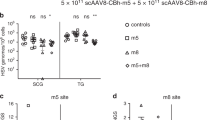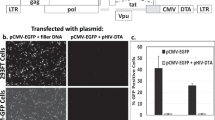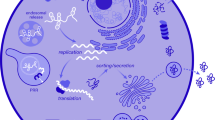Abstract
The replication-incompetent HSV-1-based vectors are herpesviruses in which genes that are ‘essential’ for viral replication have been either mutated or deleted. These deletions have substantially reduced their cytotoxicity by preventing early and late viral gene expression and, together with other deletions involving ‘nonessential’ genes, have also created space to introduce distinct and independently regulated expression cassettes for different transgenes. Therapeutic effects in gene therapy applications requiring simultaneous and synergic expression of multiple gene products are easily achievable with these vectors. A number of different HSV-1-based nonreplicative vectors for specific gene therapy applications have been developed so far. They have been tested in different gene therapy animal models of neuropathies (Parkinson's disease, chronic pain, spinal cord injury pain) and lysosomal storage disorders. Many replication-incompetent HSV-1-based vectors have also been used either as potential anti-herpes vaccines, as well as vaccine vectors for other pathogens in murine and simian models. Anticancer gene therapy approaches have also been successfully set up; gene therapy to other targets by using these vectors is feasible.
This is a preview of subscription content, access via your institution
Access options
Subscribe to this journal
Receive 12 print issues and online access
$259.00 per year
only $21.58 per issue
Buy this article
- Purchase on Springer Link
- Instant access to full article PDF
Prices may be subject to local taxes which are calculated during checkout


Similar content being viewed by others
References
Marconi P et al. Replication-defective herpes simplex virus vectors for gene transfer in vivo. Proc Natl Acad Sci USA 1996; 93: 11319–11320.
Wu N, Watkins SC, Schaffer PA, DeLuca NA . Prolonged gene expression and cell survival after infection by a herpes simplex virus mutant defective in the immediate-early genes encoding ICP4, ICP27, and ICP22. J Virol 1996; 70: 6358–6369.
Hardwicke MA, Sandri-Goldin RM . The herpes simplex virus regulatory protein ICP27 contributes to the decrease in cellular mRNA levels during infection. J Virol 1994; 68: 4797–4810.
Hardy WR, Sandri-Goldin RM . Herpes simplex virus inhibits host cell splicing, and regulatory protein ICP27 is required for this effect. J Virol 1994; 68: 7790–7799.
Spencer CA, Dahmus ME, Rice SA . Repression of host RNA polymerase II transcription by herpes simplex virus type 1. J Virol 1997; 71: 2031–2040.
Everett RD . Trans activation of transcription by herpes virus products: requirement for two HSV-1 immediate-early polypeptides for maximum activity. EMBO J 1984; 3: 3135–3141.
Gelman IH, Silverstein S . Identification of immediate early genes from herpes simplex virus that transactivate the virus thymidine kinase gene. Proc Natl Acad Sci USA 1985; 82: 5265–5269.
York IA et al. A cytosolic herpes simplex virus protein inhibits antigen presentation to CD8+ T lymphocytes. Cell 1994; 77: 525–535.
DeLuca NA, McCarthy AM, Schaffer PA . Isolation and characterization of deletion mutants of herpes simplex virus type 1 in the gene encoding immediate-early regulatory protein ICP4. J Virol 1985; 56: 558–570.
Krisky DM et al. Rapid method for construction of recombinant HSV gene transfer vectors. Gene Therapy 1997; 4: 1120–1125.
Johnson PA, Wang MJ, Friedmann T . Improved cell survival by the reduction of immediate-early gene expression in replication-defective mutants of herpes simplex virus type 1 but not by mutation of the virion host shutoff function. J Virol 1994; 68: 6347–6362.
Krisky DM et al. Development of herpes simplex virus replication-defective multigene vectors for combination gene therapy applications. Gene Therapy 1998; 5: 1517–1530.
Moriuchi S et al. HSV vector cytotoxicity is inversely correlated with effective TK/GCV suicide gene therapy of rat gliosarcoma. Gene Therapy 2000; 7: 1483–1490.
Samaniego LA, Neiderhiser L, DeLuca NA . Persistence and expression of the herpes simplex virus genome in the absence of immediate-early proteins. J Virol 1998; 72: 3307–3320.
Marconi P et al. Replication-defective herpes simplex virus vectors for neurotrophic factor gene transfer in vitro and in vivo. Gene Therapy 1999; 6: 904–912.
Goins WF et al. A novel latency-active promoter is contained within the herpes simplex virus type 1 UL flanking repeats. J Virol 1994; 68: 2239–2252.
Samaniego LA, Wu N, DeLuca NA . The herpes simplex virus immediate-early protein ICP0 affects transcription from the viral genome and infected-cell survival in the absence of ICP4 and ICP27. J Virol 1997; 71: 4614–4625.
Kaplitt MG et al. Preproenkephalin promoter yields region-specific and long-term expression in adult brain after direct in vivo gene transfer via a defective herpes simplex viral vector. Proc Natl Acad Sci USA 1994; 91: 8979–8983.
Gage PJ, Sauer B, Levine M, Glorioso JC . A cell-free recombination system for site-specific integration of multigenic shuttle plasmids into the herpes simplex virus type 1 genome. J Virol 1992; 66: 5509–5515.
Evans C et al. Progress in development of herpes simplex virus gene vectors for treatment of rheumatoid arthritis. Adv Drug Deliv Rev 1997; 27: 41–57.
van Zijl M et al. Regeneration of herpesviruses from molecularly cloned subgenomic fragments. J Virol 1988; 62: 2191–2195.
Sathananthan B et al. Purification of herpes simplex virus type 1 by density gradient centrifugation and estimation of the sedimentation coefficient of the virion. Apmis 1997; 105: 238–246.
Szilagyi JF, Cunningham C . Identification and characterization of a novel non-infectious herpes simplex virus-related particle. J Gen Virol 1991; 72 (Part 3): 661–668.
Jiang C et al. Immobilized cobalt affinity chromatography provides a novel, efficient method for herpes simplex virus type 1 gene vector purification. J Virol 2004; 78: 8994–9006.
Ozuer A et al. Effect of genetic background and culture conditions on the production of herpesvirus-based gene therapy vectors. Biotechnol Bioeng 2002; 77: 685–692.
Goins WF et al. Delivery using herpes simplex virus: an overview. Methods Mol Biol 2004; 246: 257–299.
Goins WF et al. Herpes simplex virus type 1 vector-mediated expression of nerve growth factor protects dorsal root ganglion neurons from peroxide toxicity. J Virol 1999; 73: 519–532.
Puskovic V et al. Prolonged biologically active transgene expression driven by HSV LAP2 in brain in vivo. Mol Ther 2004; 10: 67–75.
Berthomme H et al. Evidence for a bidirectional element located downstream from the herpes simplex virus type 1 latency-associated promoter that increases its activity during latency. J Virol 2000; 74: 3613–3622.
Palmer JA et al. Development and optimization of herpes simplex virus vectors for multiple long-term gene delivery to the peripheral nervous system. J Virol 2000; 74: 5604–5618.
Burton EA, Glorioso JC, Fink DJ . Gene therapy progress and prospects: Parkinson's disease. Gene Therapy 2003; 10: 1721–1727.
Yamada M et al. Herpes simplex virus vector-mediated expression of Bcl-2 prevents 6-hydroxydopamine-induced degeneration of neurons in the substantia nigra in vivo. Proc Natl Acad Sci USA 1999; 96: 4078–4083.
Goss JR et al. Antinociceptive effect of a genomic herpes simplex virus-based vector expressing human proenkephalin in rat dorsal root ganglion. Gene Therapy 2001; 8: 551–556.
Liu J et al. Peripherally delivered glutamic acid decarboxylase gene therapy for spinal cord injury pain. Mol Ther 2004; 10: 57–66.
Chattopadhyay M et al. Protective effect of herpes simplex virus-mediated neurotrophin gene transfer in cisplatin neuropathy. Brain 2004; 127: 929–939.
Lanzi G, Ottolini A . Classification of neuromuscular diseases. Monaldi Arch Chest Dis 1993; 48: 62–64.
Korsching S . The neurotrophic factor concept: a reexamination. J Neurosci 1993; 13: 2739–2748.
Marconi P et al. Effects of defective herpes simplex vectors expressing neurotrophic factors on the proliferation and differentiation of nervous cells in vivo. Gene Therapy 2005; 12: 559–569.
Farrell HE et al. Vaccine potential of a herpes simplex virus type 1 mutant with an essential glycoprotein deleted. J Virol 1994; 68: 927–932.
Morrison LA, Knipe DM . Immunization with replication-defective mutants of herpes simplex virus type 1: sites of immune intervention in pathogenesis of challenge virus infection. J Virol 1994; 68: 689–696.
Nguyen LH, Knipe DM, Finberg RW . Replication-defective mutants of herpes simplex virus (HSV) induce cellular immunity and protect against lethal HSV infection. J Virol 1992; 66: 7067–7072.
Murphy CG et al. Vaccine protection against simian immunodeficiency virus by recombinant strains of herpes simplex virus. J Virol 2000; 74: 7745–7754.
Lauterbach H et al. Protection from bacterial infection by a single vaccination with replication-deficient mutant herpes simplex virus type 1. J Virol 2004; 78: 4020–4028.
Kuklin NA et al. Modulation of mucosal and systemic immunity by enteric administration of nonreplicating herpes simplex virus expressing cytokines. Virology 1998; 240: 245–253.
Brockman MA, Knipe DM . Herpes simplex virus vectors elicit durable immune responses in the presence of preexisting host immunity. J Virol 2002; 76: 3678–3687.
Burton EA, Glorioso JC . Multi-modal combination gene therapy for malignant glioma using replication-defective HSV vectors. Drug Discov Today 2001; 6: 347–356.
Wolfe D et al. Safety and biodistribution studies of an HSV multigene vector following intracranial delivery to non-human primates. Gene Therapy 2004; 11: 1675–1684.
Niranjan A et al. Effective treatment of experimental glioblastoma by HSV vector-mediated TNF alpha and HSV-tk gene transfer in combination with radiosurgery and ganciclovir administration. Mol Ther 2000; 2: 114–120.
Niranjan A et al. Treatment of rat gliosarcoma brain tumors by HSV-based multigene therapy combined with radiosurgery. Mol Ther 2003; 8: 530–542.
Marconi P et al. Connexin 43-enhanced suicide gene therapy using herpesviral vectors. Mol Ther 2000; 1: 71–81.
Raffaella R et al. The interferon-inducible IFI16 gene inhibits tube morphogenesis and proliferation of primary, but not HPV16 E6/E7-immortalized human endothelial cells. Exp Cell Res 2004; 293: 331–345.
Sasaki K et al. Gene therapy using replication-defective herpes simplex virus vectors expressing nerve growth factor in a rat model of diabetic cystopathy. Diabetes 2004; 53: 2723–2730.
Fradette J et al. HSV vector-mediated transduction and GDNF secretion from adipose cells. Gene Therapy 2005; 12: 48–58.
Acknowledgements
Part of the research works cited in this review have been supported by the Italian Ministry for the University and Scientific Research (FISR), the Italian National Institute of Health (Program Stem Cells, CS 126.1 and ICAV, Italian Concerted Action on HIV-AIDS Vaccine Development) and the Italian Association for Cancer Research (AIRC).
Author information
Authors and Affiliations
Rights and permissions
About this article
Cite this article
Berto, E., Bozac, A. & Marconi, P. Development and application of replication-incompetent HSV-1-based vectors. Gene Ther 12 (Suppl 1), S98–S102 (2005). https://doi.org/10.1038/sj.gt.3302623
Published:
Issue Date:
DOI: https://doi.org/10.1038/sj.gt.3302623



